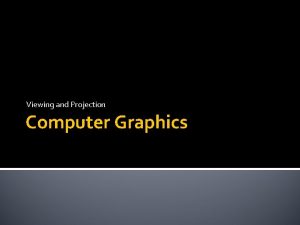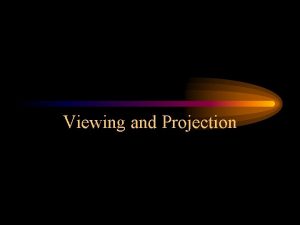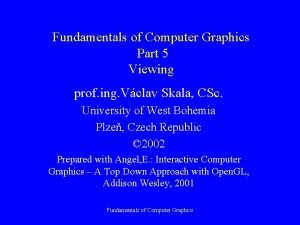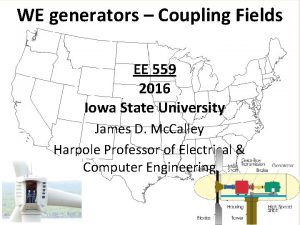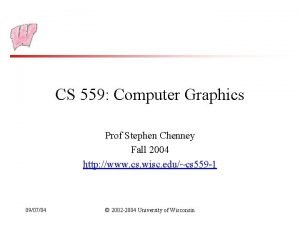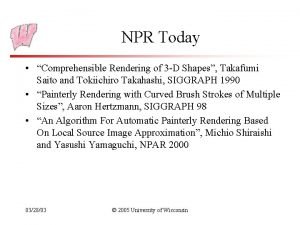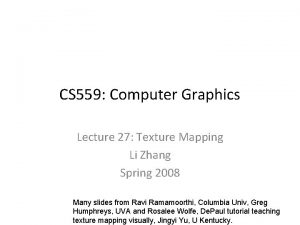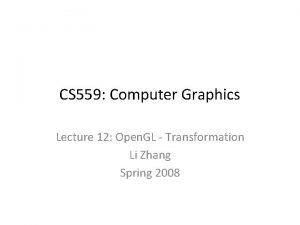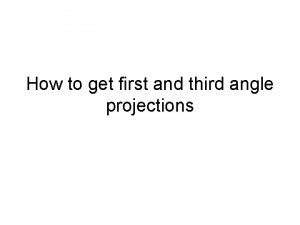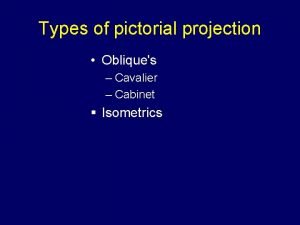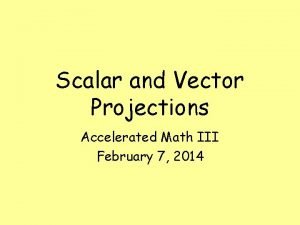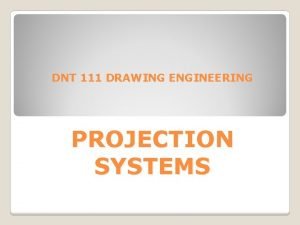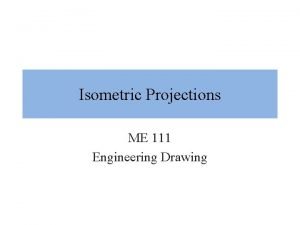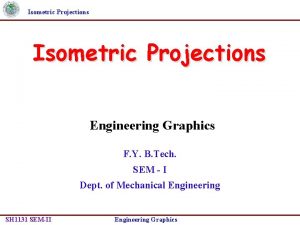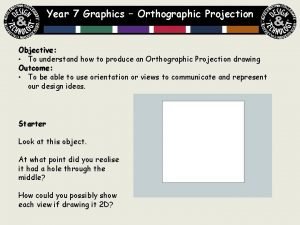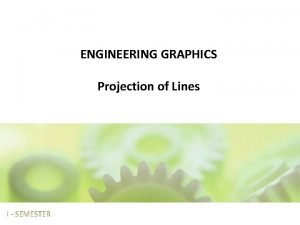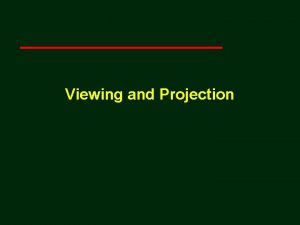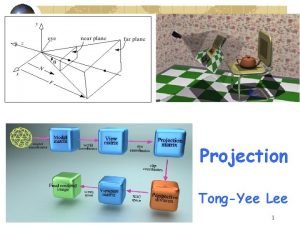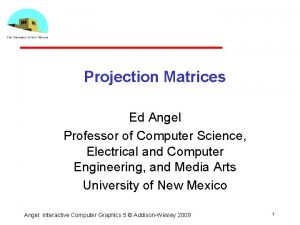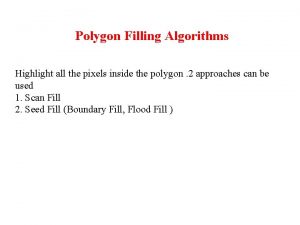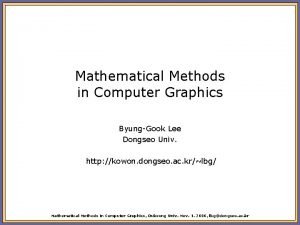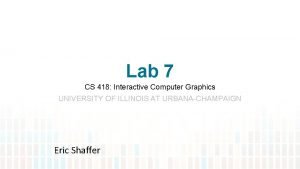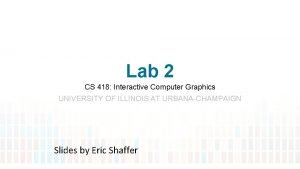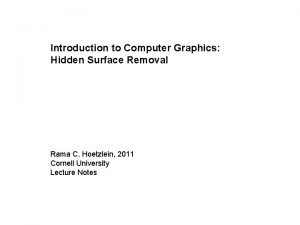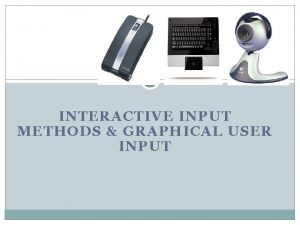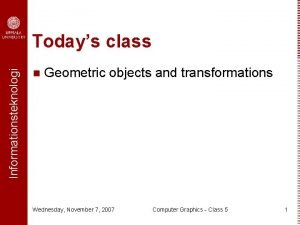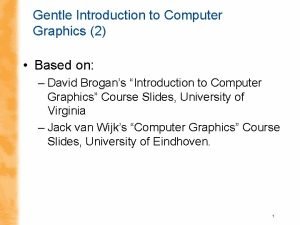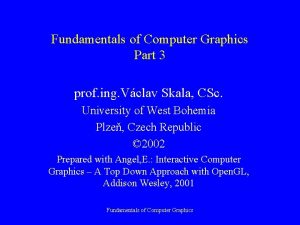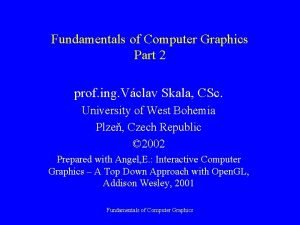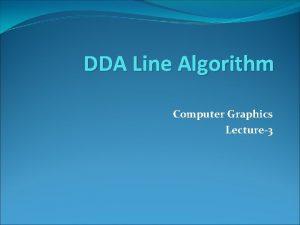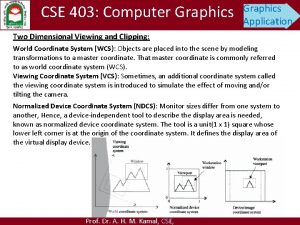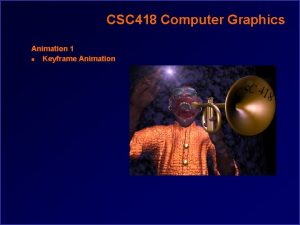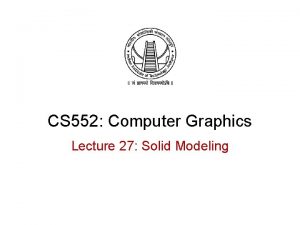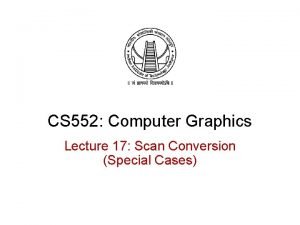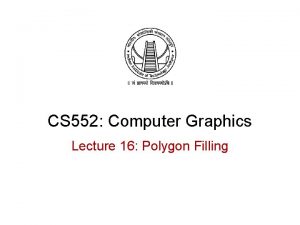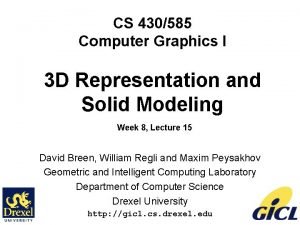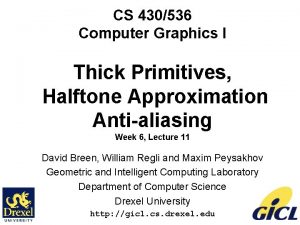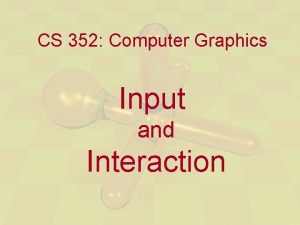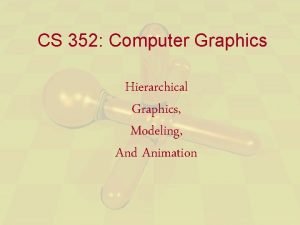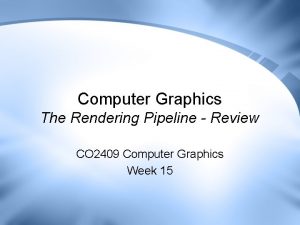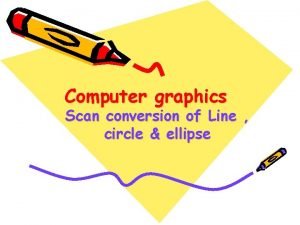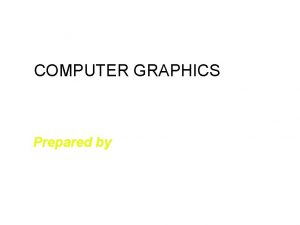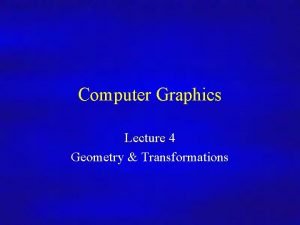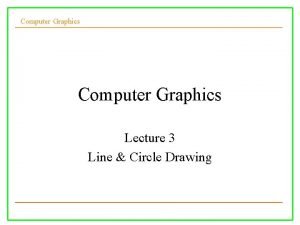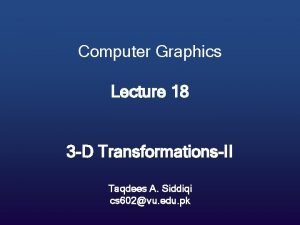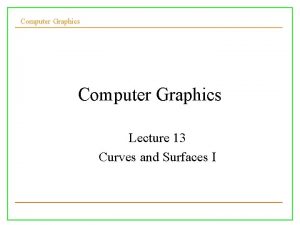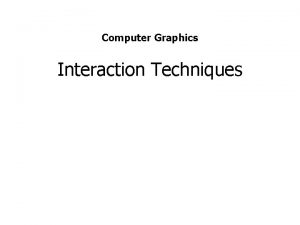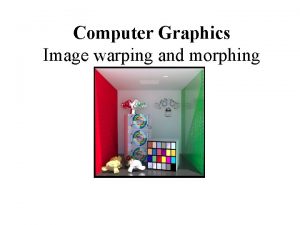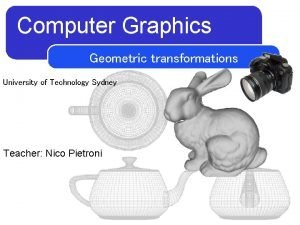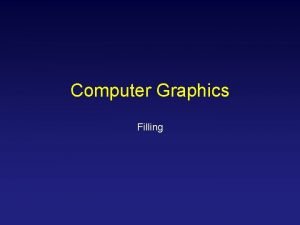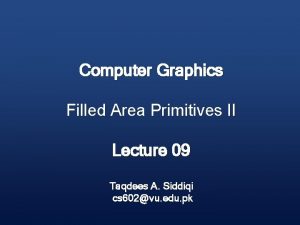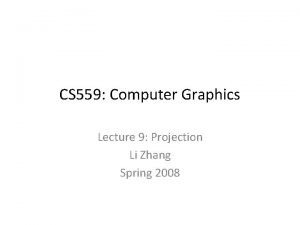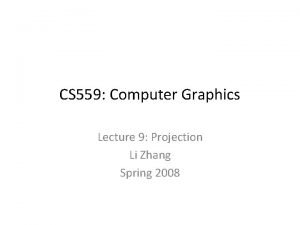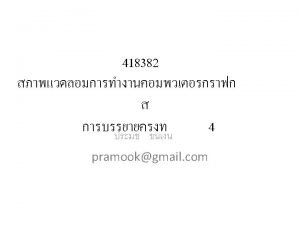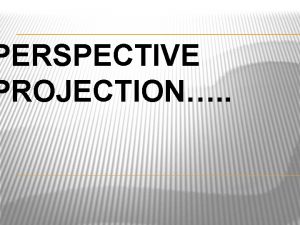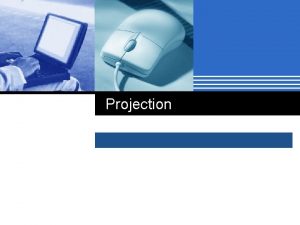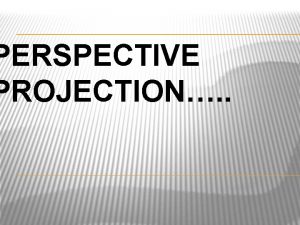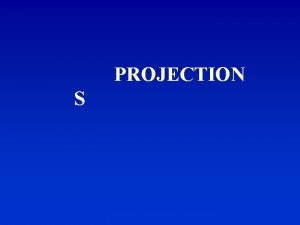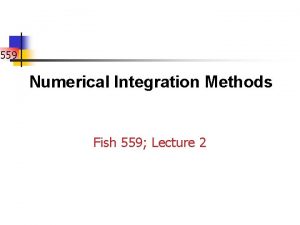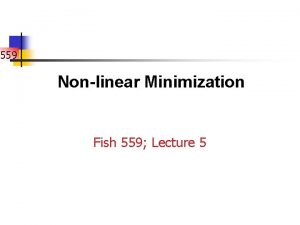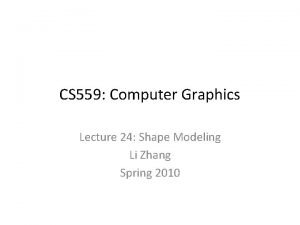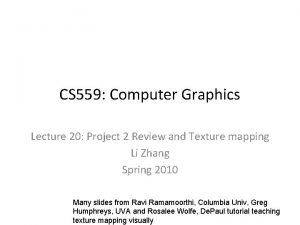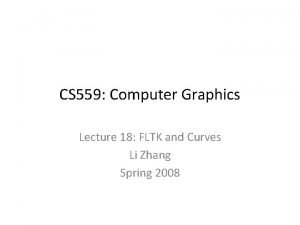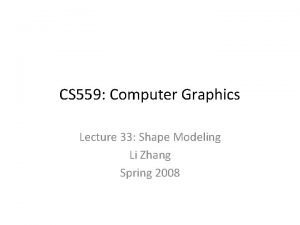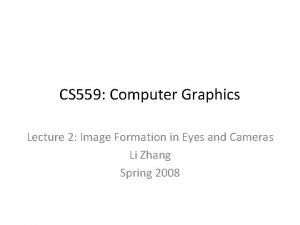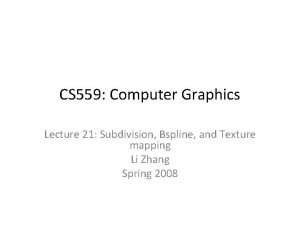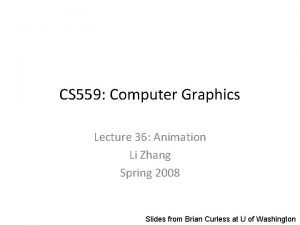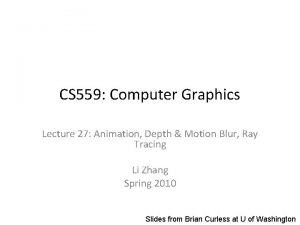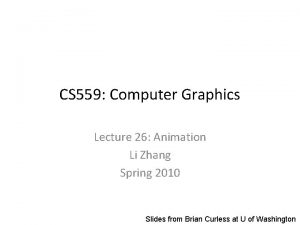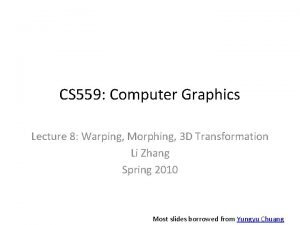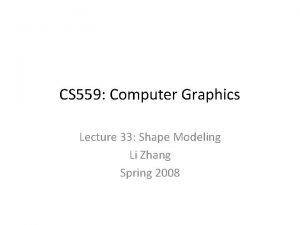CS 559 Computer Graphics Lecture 9 Projection Li



































































![Z-buffer • • The Z-buffer or depth buffer algorithm [Catmull, 1974] is probably the Z-buffer • • The Z-buffer or depth buffer algorithm [Catmull, 1974] is probably the](https://slidetodoc.com/presentation_image_h/9db9225cbca92778b3a9dc417da37f4b/image-68.jpg)







- Slides: 75

CS 559: Computer Graphics Lecture 9: Projection Li Zhang Spring 2008

Today • Projection • Reading: – Shirley ch 7

Geometric Interpretation 3 D Rotations • Can construct rotation matrix from 3 orthonormal vectors • Rows of matrix are 3 unit vectors of new coord frame • Effectively, projections of point into new coord frame

The 3 D synthetic camera model The synthetic camera model involves two components, specified independently: • objects (a. k. a. geometry) • viewer (a. k. a. camera)

Imaging with the synthetic camera The image is rendered onto an image plane or projection plane (usually in front of the camera). Projectors emanate from the center of projection (COP) at the center of the lens (or pinhole). The image of an object point P is at the intersection of the projector through P and the image plane.

Specifying a viewer Camera specification requires four kinds of parameters: �� Position: the COP. �� Orientation: rotations about axes with origin at the COP. �� Focal length: determines the size of the image on the film plane, or the field of view. �� Film plane: its width and height.

3 D Geometry Pipeline Model Space (Object Space) World Space Rotation Translation Resizing

3 D Geometry Pipeline Model Space (Object Space) World Space Rotation Translation Resizing Rotation Translation Eye Space (View Space) Projective, Scale Translation

3 D Geometry Pipeline (cont’d) Normalized Projection Space Project Screen Space (2 D) Scale Translation Image Space (pixels) Raster Space

World -> eye transformation • Let’s look at how we would compute the world ->eye transformation.

World -> eye transformation • Let’s look at how we would compute the world ->eye transformation.

How to specify eye coordinate? 1. Give eye location e 2. Give target position p 3. Give upward direction u Open. GL has a helper command: glu. Look. At (eyex, eyey, eyez, px, py, pz, upx, upy, upz )

Projections • Projections transform points in n-space to m-space, where m<n. • In 3 -D, we map points from 3 -space to the projection plane (PP) (a. k. a. , image plane) along projectors (a. k. a. , viewing rays) emanating from the center of projection (COP): • There are two basic types of projections: – Perspective – distance from COP to PP finite – Parallel – distance from COP to PP infinite

Parallel projections • For parallel projections, we specify a direction of projection (DOP) instead of a COP. • We can write orthographic projection onto the z=0 plane with a simple matrix, such that x’=x, y’=y.

Parallel projections • For parallel projections, we specify a direction of projection (DOP) instead of a COP. • We can write orthographic projection onto the z=0 plane with a simple matrix, such that x’=x, y’=y. • Normally, we do not drop the z value right away. Why not?

Properties of parallel projection • Properties of parallel projection: – Are actually a kind of affine transformation • Parallel lines remain parallel • Ratios are preserved • Angles not (in general) preserved – Not realistic looking – Good for exact measurements, Most often used in • CAD, • architectural drawings, • etc. , where taking exact measurement is important

Perspective effect

Perspective Illusion

Perspective Illusion

Derivation of perspective projection Consider the projection of a point onto the projection plane: By similar triangles, we can compute how much the x and y coordinates are scaled:

Homogeneous coordinates and perspective projection Now we can re-write the perspective projection as a matrix equation: Orthographic projection

Vanishing points What happens to two parallel lines that are not parallel to the projection plane? Think of train tracks receding into the horizon. . . The equation for a line is: After perspective transformation we get:

Vanishing points (cont'd) Dividing by w: Letting t go to infinity: We get a point! What happens to the line l = q + tv? Each set of parallel lines intersect at a vanishing point on the PP. Q: How many vanishing points are there?

Vanishing points

Vanishing points

Vanishing points

General Projective Transformation The perspective projection is an example of a projective transformation.

Properties of perspective projections Here are some properties of projective transformations: – Lines map to lines – Parallel lines do not necessarily remain parallel – Ratios are not preserved One of the advantages of perspective projection is that size varies inversely with distance – looks realistic. A disadvantage is that we can't judge distances as exactly as we can with parallel projections.

3 D Geometry Pipeline Model Space (Object Space) World Space Rotation Translation Resizing Rotation Translation Eye Space (View Space) Projective, Scale Translation

Clipping and the viewing frustum The center of projection and the portion of the projection plane that map to the final image form an infinite pyramid. The sides of the pyramid are clipping planes. Frequently, additional clipping planes are inserted to restrict the range of depths. These clipping planes are called the near and far or the hither and yon clipping planes. All of the clipping planes bound the viewing frustum.

Clipping and the viewing frustum • Notice that it doesn’t really matter where the image plane is located, once you define the view volume – You can move it forward and backward along the z axis and still get the same image, only scaled Usually d = near

Clipping Planes xv The left/right/top/bottom planes are defined according to where they cut the near clip plane Left Clip Plane Near Clip Plane n l View Volume r Need 6 parameters, Or, define the left/right and top/bottom clip planes by the field of view Far Clip Plane f -zv Right Clip Plane

Field of View xv Assumes a symmetric view volume. Near Clip Left Clip Plane FOV View Volume Far Clip Plane f -zv Right Clip Plane Need 4 parameters, Or, define the near, fov, aspect ratio

Focal Distance to FOV • You must have the image size to do this conversion – Why? Same d, different image size, different FOV height/2 d FOV/2 d

Perspective Parameters • We have seen three different ways to describe a perspective camera – Clipping planes, Field of View, Focal distance, • The most general is clipping planes – they directly describe the region of space you are viewing • For most graphics applications, field of view is the most convenient • You can convert one thing to another

Perspective Projection Matrices • We want a matrix that will take points in our perspective view volume and transform them into the orthographic view volume – This matrix will go in our pipeline before an orthographic projection matrix (r, t, f) (r, t, n) (l, b, n) (r, t, f)

Mapping Lines y -z • We want to map all the lines through the center of projection to parallel lines – This converts the perspective case to the orthographic case, we can use all our existing methods • The relative intersection points of lines with the near clip plane should not change • The matrix that does this looks like the matrix for our simple perspective case n f

How to get this mapping? y -z n f

Properties of this mapping y -z n f If z = n, M(x, y, z, 1) = [x, y, z, 1] near plane is unchanged If x/z = c 1, y/z = c 2, then x’=n*c 1, y’=n*c 2 bending converging rays to parallel rays If z 1 < z 2, z 1’ < z 2’ z ordering is preserved In pyramid In cube

General Perspective

To Canonical view volume • Perspective projection transforms a pyramid volume to an orthographic view volume (r, t, f) (r, t, n) (l, b, n) Rotate, translate (-1, 1, -1) (1, -1, 1) Canonical view volume [-1, 1]^3

Orthographic View to Canonical Matrix

Orthographic View to Canonical Matrix

Complete Perspective Projection • After applying the perspective matrix, we map the orthographic view volume to the canonical view volume:

3 D Geometry Pipeline Model Space (Object Space) World Space Rotation Translation Resizing Rotation Translation Eye Space (View Space) Projective, Scale Translation

3 D Geometry Pipeline (cont’d) Normalized Projection Space Project Screen Space (2 D) Scale Translation Image Space (pixels) Raster Space

Canonical Window Transform (xmax, ymax)=(nx-0. 5, ny-0. 5) ny-1 (1, 1) (-1, -1) (xmin, ymin)=(-0. 5, -0. 5) nx-1

Polygon is the basic shape primitive • Any 3 D shape can be approximated by a polygon using a locally linear (planar) approximation. To improve the quality of fit, we need only increase the number of edges

Line Drawing for x = x 0 to x 1 do y=y 0+(∆y/∆x)(x-x 0) draw(x, round(y)) (x 1, y 1) (x 0, y 0)

Line Drawing y = y 0 for x = x 0 to x 1 do draw(x, y) if (some condition) then y=y+1 (x 1, y 1) (x 0, y 0)

Implicit Line Drawing y = y 0 for x = x 0 to x 1 do draw(x, y) if (some condition) then f(x+1, y+0. 5)<0 y=y+1 (x 1, y 1) (x 0, y 0)

Implicit Line Drawing y = y 0 for x = x 0 to x 1 do draw(x, y) if (some condition) then f(x+1, y+0. 5)<0 y=y+1 (x 1, y 1) (x 0, y 0)

Implicit Line Drawing d=f(x+1, y+0. 5) y = y 0 for x = x 0 to x 1 do draw(x, y) if (some condition) then d<0 D=d-∆y+∆x y=y+1 else D=d-∆y (x 1, y 1) (x 0, y 0)

Implicit Line Drawing d=2 f(x+1, y+0. 5) y = y 0 for x = x 0 to x 1 do draw(x, y) if (some condition) then d<0 D=d-2∆y+2∆x y=y+1 else D=d-2∆y (x 1, y 1) (x 0, y 0)

Implicit Line Drawing d=2 f(x+1, y+0. 5) y = y 0 for x = x 0 to x 1 do draw(x, y) if (some condition) then d<0 D=d-2∆y+2∆x y=y+1 else D=d-2∆y (x 1, y 1) (x 0, y 0)

Implicit Line Drawing d=2 f(x+1, y+0. 5) y = y 0 for x = x 0 to x 1 do draw(x, y) if (some condition) then d<0 D=d-2∆y+2∆x y=y+1 else D=d-2∆y

Implicit Line Drawing d=2 f(x+1, y+0. 5) y = y 0 for x = x 0 to x 1 do draw(x, y) if (some condition) then d<0 D=d-2∆y+2∆x y=y+1 else D=d-2∆y If ∆y>∆x, switch x and y

Drawing Triangle

Drawing Triangle A 2 for all y do for all x do if (in triangle) then draw(x, y) with color c P A 1 A 3

Drawing Triangle for all y do for all x do compute t 1, t 2, t 3 if t 1, t 2, t 3 in [0, 1] then draw(x, y) with color t 1 c 1+t 2 c 2+t 3 c 3 A 2 P A 1 A 3

Common Edge for all y do for all x do compute t 1, t 2, t 3 if t 1, t 2, t 3 in [0, 1] then draw(x, y) with color t 1 c 1+t 2 c 2+t 3 c 3

Aliasing in rendering • One of the most common rendering artifacts is the “jaggies”. Consider rendering a white polygon against a black background: • We would instead like to get a smoother transition:

Anti-aliasing • Q: How do we avoid aliasing artifacts? 1. Sampling: 2. Pre-filtering: 3. Combination: • Example - polygon:

Polygon anti-aliasing

Aliasing 1. Increase sampling rate -- not practical for fixed resolution display. 2. Smooth out high frequences analytically. Requires an analytic function. Hardly available in any given scene for ray tracing. 3. Supersample and average down.

Aliasing 1. Increase sampling rate -- not practical for fixed resolution display. 2. Smooth out high frequences analytically. Requires an analytic function. Hardly available in any given scene for ray tracing. 3. Supersample and average down.

Aliasing 1. Increase sampling rate -- not practical for fixed resolution display. 2. Smooth out high frequences analytically. Requires an analytic function. Hardly available in any given scene for ray tracing. 3. Supersample and average down.
![Zbuffer The Zbuffer or depth buffer algorithm Catmull 1974 is probably the Z-buffer • • The Z-buffer or depth buffer algorithm [Catmull, 1974] is probably the](https://slidetodoc.com/presentation_image_h/9db9225cbca92778b3a9dc417da37f4b/image-68.jpg)
Z-buffer • • The Z-buffer or depth buffer algorithm [Catmull, 1974] is probably the simplest and most widely used. Here is pseudocode for the Z-buffer hidden surface algorithm: Q: What should FAR be set to?

Mapping of Z is nonlinear • • • Many mappings proposed: all have nonlinearities Advantage: handles range of depths (10 cm – 100 m) Disadvantage: depth resolution not uniform More close to near plane, less further away Common mistake: set near = 0, far = infty. Don’t do this. Can’t set near = 0; lose depth resolution.

Other issues of Z buffer • Order is needed for translucent objects • Depth accuracy

Binary-space partitioning (BSP) trees A C B D • Idea: – Do extra preprocessing to allow quick display from any viewpoint. • Key observation: A polygon A is painted in correct order if – Polygons on far side of A are painted first – A is painted next – Polygons on near side of A are painted last.

BSP tree creation What if you are on one of the support planes? ?

BSP tree creation (cont’d) • • • procedure Make. BSPTree: takes Polygon. List L returns BSPTree Choose polygon A from L to serve as root Split all polygons in L according to A node. neg Make. BSPTree(Polygons on neg. side of A) node. pos Make. BSPTree(Polygons on pos. side of A) return node end procedure Note: Performance is improved when fewer polygons are split --- in practice, best of ~ 5 random splitting polygons are chosen. Note: BSP is created in world coordinates. No projective matrices are applied before building tree.

BSP tree display • procedure Display. BSPTree: • Takes BSPTree T • if T is empty then return • if viewer is in front (on pos. side) of T. node • Display. BSPTree(T. _____ ) • Draw T. node • Display. BSPTree(T. _____) • else • Display. BSPTree(T. _____) • Draw T. node • Display. BSPTree(T. _____) • end if • end procedure

BSP trees: Analysis w w w Easy to implement? Easy to implement in hardware? Incremental drawing calculations (uses coherence)? Pre-processing required? On-line (doesn’t need all objects before drawing begins)? If objects move, does it take more work than normal to draw the frame? If the viewer moves, does it take more work than normal to draw the frame? Typically polygon-based? Efficient shading (doesn’t compute colors of hidden surfaces)? Handles transparency? Handles refraction?
 Define projection in computer graphics
Define projection in computer graphics Projection in computer graphics
Projection in computer graphics Parallel projection in computer graphics
Parallel projection in computer graphics Fundamentals of computer graphics
Fundamentals of computer graphics Most of the graphics monitors today operate as
Most of the graphics monitors today operate as Computer graphics chapter 1 ppt
Computer graphics chapter 1 ppt Ee 559
Ee 559 Cs 559
Cs 559 Cs 559 uw madison
Cs 559 uw madison Cs 559
Cs 559 Cs 559
Cs 559 01:640:244 lecture notes - lecture 15: plat, idah, farad
01:640:244 lecture notes - lecture 15: plat, idah, farad Isometric and orthographic
Isometric and orthographic Difference between 1st and 3rd angle projection
Difference between 1st and 3rd angle projection Cavalier pictorial definition
Cavalier pictorial definition Scalar vs vector projection
Scalar vs vector projection Third angle
Third angle Pentagon isometric view
Pentagon isometric view Engineering graphics isometric projection
Engineering graphics isometric projection Projection graphics
Projection graphics Engineering graphics projection of lines
Engineering graphics projection of lines Computer security 161 cryptocurrency lecture
Computer security 161 cryptocurrency lecture Computer aided drug design lecture notes
Computer aided drug design lecture notes Architecture lecture notes
Architecture lecture notes Computer architecture lecture
Computer architecture lecture Projection computer
Projection computer Tongyee
Tongyee Angel morth
Angel morth Angel
Angel What is plasma panel display in computer graphics
What is plasma panel display in computer graphics In two dimensional viewing we have?
In two dimensional viewing we have? Shear transformation in computer graphics
Shear transformation in computer graphics Shader computer graphics
Shader computer graphics Scan conversion of ellipse in computer graphics
Scan conversion of ellipse in computer graphics Center of mass of a rigid body
Center of mass of a rigid body The region of
The region of Starburst method
Starburst method Polygon filling algorithms
Polygon filling algorithms Random scan display
Random scan display Computer graphics
Computer graphics Line in computer graphics
Line in computer graphics Cs 418 interactive computer graphics
Cs 418 interactive computer graphics Glcreatebuffer
Glcreatebuffer Depth sorting method in computer graphics
Depth sorting method in computer graphics Achromatic light in computer graphics
Achromatic light in computer graphics Interactive picture construction techniques
Interactive picture construction techniques Uniform scaling in computer graphics
Uniform scaling in computer graphics Uniform scaling in computer graphics
Uniform scaling in computer graphics Logical input devices in computer graphics
Logical input devices in computer graphics Sierpinski gasket in computer graphics
Sierpinski gasket in computer graphics Polygon clipping in computer graphics ppt
Polygon clipping in computer graphics ppt Introduction to computer graphics ppt
Introduction to computer graphics ppt Dda computer graphics
Dda computer graphics What is window and viewport in computer graphics
What is window and viewport in computer graphics Keyframe animation in computer graphics
Keyframe animation in computer graphics Solid modeling in computer graphics
Solid modeling in computer graphics Scan conversion in computer graphics
Scan conversion in computer graphics 8 connected boundary fill algorithm
8 connected boundary fill algorithm Boundary representation in computer graphics
Boundary representation in computer graphics Thick primitives in computer graphics
Thick primitives in computer graphics Interaction in computer graphics
Interaction in computer graphics Hierarchical modeling in computer graphics
Hierarchical modeling in computer graphics Computer graphics pipeline
Computer graphics pipeline Direct method line drawing algorithm
Direct method line drawing algorithm Srgp in computer graphics
Srgp in computer graphics Concatenation in computer graphics
Concatenation in computer graphics Midpoint line drawing algorithm
Midpoint line drawing algorithm Uniform scaling in computer graphics
Uniform scaling in computer graphics Hermite curve in computer graphics
Hermite curve in computer graphics Dragging in computer graphics
Dragging in computer graphics Edge table in computer graphics
Edge table in computer graphics Warping in computer graphics
Warping in computer graphics Warping and morphing
Warping and morphing Frame yv
Frame yv Scan line polygon fill algorithm
Scan line polygon fill algorithm Filled area primitives
Filled area primitives

